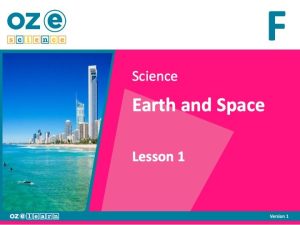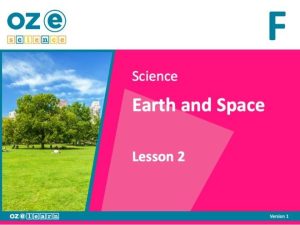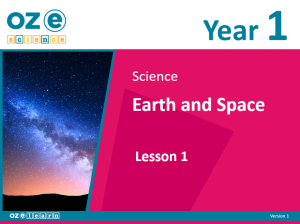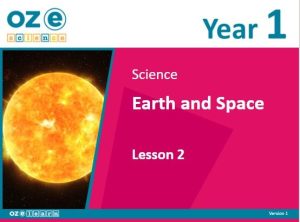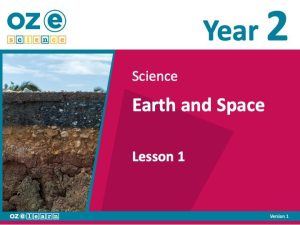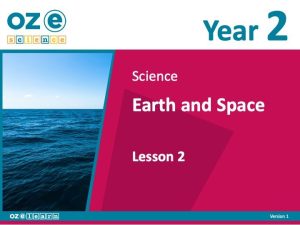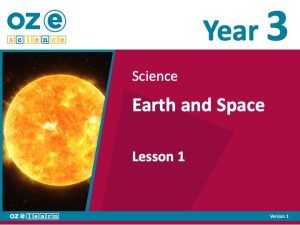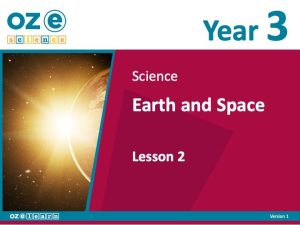Oz-e-science – Earth and Space – Version 1
Foundation – Year 6
Oz-e-science Earth and Space units align to the Australian Curriculum Content Descriptions.
An early release of Version 2 is available now.
Version 1 on this page will remain available for the duration of Term 2 for schools that already have it in use.
Share this page:
Starter Lessons
Year Overview
Foundation Year
Australian Curriculum Content Descriptions
Overview
Earth and Space Foundation Year is the study of Earth and its place in space for Foundation Year students. It aligns to the Australian Curriculum Science Understanding:
- Daily and seasonal changes in our environment affect daily life (ACSSU004).
Learning Objectives
In Lessons 1 to 10, students learn about:
- different types of weather and the symbols that represent them and describing today’s weather
- tracking the weather for a wheel using weather symbols
- different air temperatures and measuring the air temperature using a simple thermometer
- different seasons and how to represent them on a season wheel
- different fruits and vegetables that are ‘in season’ during the four seasons and representing these fruits and vegetables on a season wheel
- how some animals behave differently depending on the season and representing animals that hibernate on the season wheel
- comparing the wet and dry seasons and finding places that experience these seasons
- some of the different seasons that Indigenous Australians follow and representing the three main seasons of the Tiwi Island people onto the season wheel
- planning a video about the weather and the seasons and the seasons
- creating a video about the weather and the seasons
- completing a final assessment, reporting and communicating.
Success Criteria
- Look at the different types of weather and the symbols that represent them.
- Describe today’s weather and track the weather for a week using weather symbols.
- Identify different air temperatures.
- Measure the air temperature using a simple thermometer.
- Identify the different seasons.
- Represent the seasons on a season wheel.
- Identify the different fruits and vegetables that are in season during the four different seasons.
- Represent the fruits and vegetables that are in season on the season wheel.
- Describe how some animals behave differently depending on the season.
- Represent animals that hibernate on the season wheel.
- Compare wet and dry seasons.
- Find places that have wet and dry seasons.
- Find some of the different seasons that Indigenous Australians follow.
- Represent the three main seasons of the Tiwi people on the season wheel.
- Plan a video about the weather and the seasons.
- Create a video about the weather and the seasons.
Assessment
Progress Tests
Progress tests are conducted after every second lesson, allowing teachers to monitor student understanding of the concepts taught over the past two lessons and to identify where reteaching is needed. The Teaching Guide contains the testing questions, and the Student Workbook has a section where students write their answers and score themselves.
Structured Research Activity
The Structured Research Activity (SRA) for this unit is: Students create and present a video on the weather and the seasons. The SRA takes place over two lessons so students can apply the Science Understanding and Science Inquiry Skills covered in the unit. Teachers use the Guide to Making Judgements, which is included in the Teaching Guide, to mark the SRA.
End-of-Unit Assessment
The last lesson is the end-of-unit assessment, which has a variety of question formats (e.g., label the diagram, circle the correct answer) to assess student mastery of content from the unit. The end-of-unit assessment is in the Teaching Guide. Teachers copy the assessment and distribute to students at testing time.
Year 1
Australian Curriculum Content Descriptions
Overview
Earth and Space Year 1 is the study of Earth and its place in space for Year 1 students. It aligns to the Australian Curriculum Science Understanding:
- Observable changes occur in the sky and landscape (ACSSU019).
Learning Objectives
In Lessons 1 to 9, students learn about:
- describing the objects in the sky during the day and at night and representing day and night on a model of a globe
- describing the Sun and observing its position through the day and night
- describing the features of the night sky and how they reflect the Sun’s light at night so we can see them
- recording and explaining how Indigenous Australians use the sky
- identifying the different constellations in the sky and making a model of a feature of the night sky – a constellation
- identifying different types of extreme weather and analysing an extreme weather event
- describing and identifying the features of landscapes
- planning a daytime and night-time poster of a landscape
- representing a daytime and night-time landscape by drawing a poster.
Success Criteria
- Describe the objects in the sky in the day and at night.
- Represent day and night on a model of the globe.
- Describe the sun.
- Observe the position of the Sun throughout the day and night.
- Describe the features of the night sky.
- Look at how features in the night sky reflect the Sun’s light at night so we can see them.
- Record how Indigenous Australians use the sky.
- Explain how Indigenous Australians use the sky.
- Identify different constellations in the sky.
- Make a model of a feature of the night sky – a constellation.
- Identify types of extreme weather.
- Analyse an extreme weather event.
- Describe the features of landscapes.
- Identify the different features of a landscape.
- Plan a daytime and night-time poster of a landscape.
- Represent a daytime and night-time landscape by drawing a poster.
Assessment
Progress Tests
Progress tests are conducted after every second lesson, allowing teachers to monitor student understanding of the concepts taught over the past two lessons and to identify where reteaching is needed. The Teaching Guide contains the testing questions, and the Student Workbook has a section where students write their answers and score themselves.
Structured Research Activity
The Structured Research Activity (SRA) for this unit is: Students create and present a poster to show changes in daytime and night-time landscapes. The SRA takes place over two lessons so students can apply the Science Understanding and Science Inquiry Skills covered in the unit. Teachers use the Guide to Making Judgements, which is included in the Teaching Guide, to mark the SRA.
End-of-Unit Assessment
The last lesson is the end-of-unit assessment, which has a variety of question formats (e.g. label the diagram, circle the correct answer) to assess student mastery of content from the unit. The end-of-unit assessment is in the Teaching Guide. Teachers copy the assessment and distribute to students at testing time.
Year 2
Australian Curriculum Content Descriptions
Overview
Earth and Space Year 2 is the study of Earth and its place in space for Year 2 students. It aligns to the Australian Curriculum Science Understanding:
- Earth’s resources are used in a variety of ways (ACSSU032).
Learning Objectives
In Lessons 1 to 9, students learn about:
- the Earth and what it is made of and comparing the water and land covering the Earth’s surface
- water on Earth and making a model showing how water is used as a resource
- what soil is like in the school garden, how soil forms and how it is used by humans
- important minerals on Earth and the periodic table and comparing their properties
- the ways we move resources in the world and building a model ship to transport resources
- what might happen if a resource runs out and a comparison of food resources in Australia to another country
- the ways Indigenous Australians use natural resources and weaving using reeds
- ways to conserve water resources in their community
- planning and reporting an awareness campaign to conserve water resources in their community.
Success Criteria
- Describe the Earth and what it is made of.
- Compare total water to total land on the surface of the Earth.
- Identify examples of water on Earth.
- Make a model to show how water is used by humans as a resource.
- Describe different soil types by what they look, feel and smell like, and what is growing in them.
- Explain what makes soil and how it is used by humans.
- Identify mineral resources that humans use.
- Identify minerals on the periodic table.
- Compare the properties of minerals in everyday products.
- Describe the ways resources are moved around the planet.
- Make a model cargo ship.
- Explain what might happen if a resource runs out.
- Compare the food resources of different people.
- Identify the ways Indigenous Australians use local resources.
- Investigate the use of reeds to weave useful items.
- Observe the ways water is used in a house and school.
- Identify the ways water can be saved more or used less.
- Plan a poster to communicate water conservation.
- Report ideas about water conservation using a poster.
Assessment
Progress Tests
Progress tests are conducted after every second lesson, allowing teachers to monitor student understanding of the concepts taught over the past two lessons and to identify where reteaching is needed. The Teaching Guide contains the testing questions, and the Student Workbook has a section where students write their answers and score themselves.
Structured Research Activity
The Structured Research Activity (SRA) for this unit is: Students create and present a poster to convey a message about water conservation. The SRA takes place over two lessons so students can apply the Science Understanding and Science Inquiry Skills covered in the unit. Teachers use the Guide to Making Judgements, which is included in the Teaching Guide, to mark the SRA.
End-of-Unit Assessment
The last lesson is the end-of-unit assessment, which has a variety of question formats (e.g. label the diagram, circle the correct answer) to assess student mastery of content from the unit. The end-of-unit assessment is in the Teaching Guide. Teachers copy the assessment and distribute to students at testing time.
Year 3
Australian Curriculum Content Descriptions
Overview
Earth and Space Year 3 is the study of Earth and its place in space for Year 3 students. It aligns to the Australian Curriculum Science Understanding:
- Earth’s resources are used in a variety of ways (ACSSU032).
Learning Objectives
- In Lessons 1 to 9, students learn about:
- describing the Sun and comparing the sizes of different stars
- identifying the power of sunlight on Earth and making a model showing how sunlight energy is used on Earth
- why the Earth has night and day and representing day and night on a globe
- analysing why we have seasons and comparing them in different parts of the world
- the moon and its phases and representing the phases in a mobile
- planning a model of the Sun, Earth and the Moon
- comparing Indigenous Australian storytelling to the movement of Earth, the Sun and the Moon, and representing the story about how the Earth, Sun and space were made using a storyboard
- building a sundial and predicting how well it will work
- presenting the findings from the sundial investigation to the class.
Success Criteria
- Describe the Sun and other stars in the universe.
- Compare the sizes of different stars.
- Identify examples of sunlight on Earth.
- Make a model to show how sunlight energy is used on Earth.
- Explain why the Earth has night and day.
- Represent day and night on a globe.
- Analyse why we have seasons.
- Compare seasons in different parts of the world.
- Describe the Moon and its phases.
- Represent the Moon phases in a mobile.
- Identify the orbits of the Earth and the Moon.
- Explain how long each orbit takes.
- Plan the steps in making a model of the Sun, Earth and the Moon.
- Model the orbits of Earth and the Moon around the Sun.
- Compare Indigenous Australian storytelling to the movement of the Earth, the Sun and the Moon.
- Represent the story with a storyboard.
- Predict where the shadow of the pencil will fall on the sundial.
- Represent the time of day using a sundial.
- Evaluate the findings from the sundial investigation and communicate these findings to the class.
Assessment
Progress Tests
Progress tests are conducted after every second lesson, allowing teachers to monitor student understanding of the concepts taught over the past two lessons and to identify where reteaching is needed. The Teaching Guide contains the testing questions, and the Student Workbook has a section where students write their answers and score themselves.
Structured Research Activity
The Structured Research Activity (SRA) for this unit is: Students construct a sundial and present the results of their sundial investigation.
End-of-Unit Assessment
The last lesson is the end-of-unit assessment, which has a variety of question formats (e.g. label the diagram, circle the correct answer) to assess student mastery of content from the unit. The end-of-unit assessment is in the Teaching Guide. Teachers copy the assessment and distribute to students at testing time.
Year 4
Year 4, Lesson 1
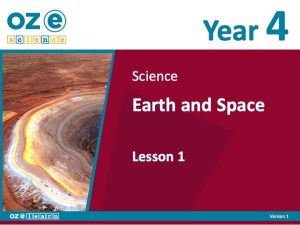
Year 4, Lesson 2
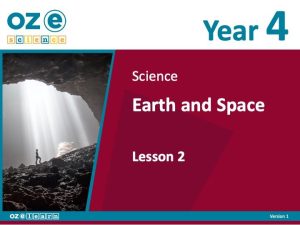
Teaching Resources
Extra Resources
Australian Curriculum Content Descriptions
Overview
Earth and Space Year 4 is the study of Earth and its place in space for Year 4 students. It aligns to the Australian Curriculum Science Understanding:
- Earth’s surface changes over time as a result of natural processes and human activity (ACSSU075).
Learning Objectives
In Lessons 1 to 10, students learn about:
- how the Earth was formed
- identifying the four main layers of Earth
- the Earth’s main tectonic plates
- continental drift theory
- landforms and how they are formed
- the three main types of rock
- how fossil fuels were formed and their uses
- researching a geological site
- writing a report using the information from your reading.
Success Criteria
- Identify the two main processes that formed the Earth.
- Explain why humans are able to live on Earth.
- Identify and label Earth’s four main layers.
- Represent a model of the Earth’s layers.
- Identify what tectonic plates are.
- Describe two examples of what happens where tectonic plates meet.
- Outline the tectonic plate boundaries.
- Explain what continental drift theory is.
- Represent Pangaea in an online puzzle.
- Describe the difference between constructive and destructive forces.
- Classify landforms created by constructive and/or destructive processes in a card game.
- Describe the three main types of rocks and how they were formed.
- Classify rocks in the rock cycle. Describe the three main types of fossil fuels.
- Plot to represent the main fossil fuel reserves on a map of Australia.
- Complete research and take notes about a geological site.
- Create an information report using your reading research about the geological site.
Assessment
Progress Tests
Progress tests are conducted after every second lesson, allowing teachers to monitor student understanding of the concepts taught over the past two lessons and to identify where reteaching is needed. The Teaching Guide contains the testing questions, and the Student Workbook has a section where students write their answers and score themselves.
Structured Research Activity
The Structured Research Activity (SRA) for this unit is: Students to research and write a report on a geological site. The SRA takes place over two lessons so students can apply the Science Understanding and Science Inquiry Skills covered in the unit. Teachers use the Guide to Making Judgements, which is included in the Teaching Guide, to mark the SRA.
End-of-Unit Assessment
The last lesson is the end-of-unit assessment which has a variety of question formats (e.g. label the diagram, circle the correct answer) to assess student mastery of content from the unit. The end-of-unit assessment is in the Teaching Guide. Teachers copy the assessment and distribute to students at testing time.
Year 5
Year 5, Lesson 1
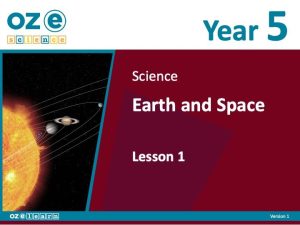
Year 5, Lesson 2
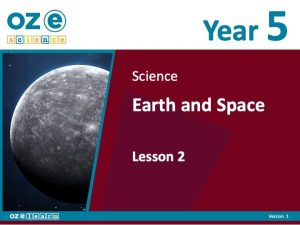
Teaching Resources
Extra Resources
Australian Curriculum Content Descriptions
Overview
Earth and Space Year 5 is the study of our solar system as a very small part of one of millions of galaxies in the universe. It aligns to the Australian Curriculum Science Understanding:
- The Earth is part of a system of planets orbiting around a star (the sun) (ACSSU078).
Learning Objectives
In Lessons 1 to 9, students learn about:
- what solar systems are
- the four rocky planets in our solar system
- the four gas planets in our solar system
- five dwarf planets in our solar system
- the moons in our solar system
- how telescopes work
- spacecraft and explain their purpose
- satellites and plan to build your own model satellite
- building your satellite and preparing a presentation.
Success Criteria
- Explain what a solar system is.
- Describe three objects in our solar system.
- Represent our own solar system as a rap song.
- Describe the four rocky planets in our Solar System.
- Explain where these rocky planets are found.
- Represent the rocky planets in a booklet.
- Describe the four gas planets in our Solar System.
- Explain where these gas planets are found.
- Represent the gas planets in a booklet.
- Describe the five dwarf planets.
- Compare dwarf planets and planets.
- Represent all the planets and dwarf planets to scale.
- Explain what moons are.
- Describe at least two moons in our solar system.
- Compare the moons of Neptune.
- Explain how a telescope works.
- Describe at least one space telescope.
- Classify different types of spacecraft.
- Describe at least three different spacecraft.
- Explain the purpose and mission of these spacecraft.
- Identify the parts of a satellite.
- Explain what the parts of a satellite are for.
- Research your chosen satellite. Build your satellite and label its parts.
- Evaluate your investigation.
- Explain your satellite and its parts.
- Plan your presentation.
- Communicate your investigation.
Assessment
Progress Tests
Progress tests are conducted after every second lesson, allowing teachers to monitor student understanding of the concepts taught over the past two lessons and to identify where reteaching is needed. The Teaching Guide contains the testing questions, and the Student Workbook has a section where students write their answers and score themselves.
Structured Research Activity
The Structured Research Activity (SRA) for this unit is: Students to build a satellite and prepare a presentation. The SRA takes place over two lessons so students can apply the Science Understanding and Science Inquiry Skills covered in the unit. Teachers use the Guide to Making Judgements, which is included in the Teaching Guide, to mark the SRA.
End-of-Unit Assessment
The last lesson is the end-of-unit assessment which has a variety of question formats (e.g., label the diagram, circle the correct answer) to assess student mastery of content from the unit. The end-of-unit assessment is in the Teaching Guide. Teachers copy the assessment and distribute to students at testing time.
Year 6
Year 6, Lesson 1
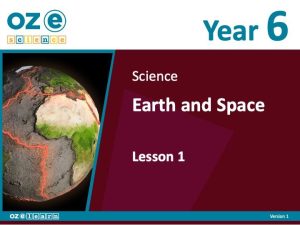
Year 6, Lesson 2
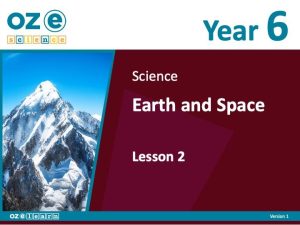
Teaching Resources
Extra Resources
Australian Curriculum Content Descriptions
Overview
Earth and Space Year 6 is the study of the composition of Earth and its atmosphere and the processes occurring within them that shape Earth’s surface and its climate. It aligns to the Australian Curriculum Science Understanding:
- Sudden geological changes and extreme weather events can affect Earth’s surface (ACSSU096).
Learning Objectives
In Lessons 1 to 9, students learn about:
- tectonic plates and their role in changing the Earth’s surface
- how mountain ranges and trenches are formed
- the formation of volcanoes
- the different types of volcanoes
- earthquakes and where they occur
- tsunamis and how they affect the Earth’s surface
- how to predict and track volcanic
- activities that have affected the Earth’s surface
- examples and causes of extreme weather events and their effects on the Earth’s surface
- researching and creating a presentation to share your findings.
Success Criteria
- Describe Earth’s tectonic plates.
- Explain what happens at plate boundaries.
- Identify a plate boundary as convergent, divergent or transform.
- Describe how mountain ranges form at convergent plate boundaries.
- Explain how trenches form at oceanic plate boundaries.
- Explain how volcanoes form.
- Describe the basic structure of a volcano.
- Explain how volcanoes affect the Earth’s surface.
- Observe how the viscosity of a volcano’s lava affects its shape.
- Classify different types of volcanoes.
- Identify signs that a volcano is about to erupt.
- Explain how volcanoes affect the Earth’s surface.
- Analyse data to determine volcanic activities.
- Describe how earthquakes form.
- Explain how earthquakes affect the Earth’s surface.
- Sequence the progression of an earthquake.
- Describe how tsunamis form.
- Explain how tsunamis affect the Earth’s surface.
- Represent how different natural events result in tsunamis.
- Predict the activity of your volcano.
- Record information of your volcano.
- Identify where weather activities occur in the atmosphere.
- Explain what extreme weather conditions mean.
- Classify extreme weather conditions.
- Research information on your volcano.
- Evaluate your findings about volcanoes.
- Plan your presentation.
- Communicate the findings from your investigation.
Assessment
Progress Tests
Progress tests are conducted after every second lesson, allowing teachers to monitor student understanding of the concepts taught over the past two lessons and to identify where reteaching is needed. The Teaching Guide contains the testing questions, and the Student Workbook has a section where students write their answers and score themselves.
Structured Research Activity
The Structured Research Activity (SRA) for this unit is: Students will research and create a presentation to share their findings on volcanoes. The SRA takes place over two lessons so students can apply the Science Understanding and Science Inquiry Skills covered in the unit. Teachers use the Guide to Making Judgements, which is included in the Teaching Guide, to mark the SRA.
End-of-Unit Assessment
The last lesson is the end-of-unit assessment which has a variety of question formats (e.g. label the diagram, circle the correct answer) to assess student mastery of content from the unit. The end-of-unit assessment is in the Teaching Guide. Teachers copy the assessment and distribute to students at testing time.

